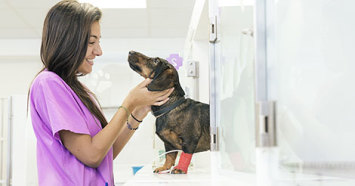
During puppy and kitten wellness exams, there comes a point where many veterinarians shift to auto-pilot as we describe the reasons for spay and neuter at or around five to six months of age (being a veterinarian myself, I can and do admit this; we are only human after all).
The questions surrounding spay and neuter haven't changed much over the years, and they are fairly predictable. Will the surgery make my pet fat? Will it change my pet's behavior? Is anesthesia safe? When should we schedule the surgery? What should I expect after surgery? These answers are all easy enough. Or so we thought.
The spay and neuter movement began as a means to help control pet overpopulation. Along the way, veterinarians discovered numerous health benefits the surgery provided to our pets. However, at the beginning of 2013, a study was released that raised some tough questions about when is the best time to spay and neuter our pets.
This is the first study that examined the effects of neutering on a number of joint disorders and cancers in the same breed of dog (Golden Retriever). The study also compared intact dogs versus those neutered less than one year of age (early neutering) and those animals neutered after one year of age. While this study is a step in the right direction, and the most comprehensive of its kind, it can't automatically be applied to all other breeds since it was performed on Golden Retrievers only.
What We Learned About Spay and Neuter Timing from the Study
Five diseases were analyzed: hip dysplasia (HD), cranial cruciate ligament tear (CCL), lymphosarcoma (LSA), hemangiosarcoma (HSA), and mast cell tumor (MCT). For all five diseases analyzed in the study, the disease rates in males and/or females were significantly increased when neutering was performed early and/or late.
For females, the timing of spaying is less clear. Early spaying significantly increases the incidence rate of cranial cruciate injury and late spaying increases the rates of HSA four times that of intact females as concluded by the study.
Benefits of Early or Late Spaying and Neutering
What should not be ignored is that spaying female dogs before their first heat cycle still has tremendous health benefits by protecting against other diseases such as pyometra and mammary cancer.
Neutering males, or at least Golden Retrievers, well beyond puberty seems to avoid the problems of increased rates of occurrence of HD, CCL, and LSA that all occur at increased incidence with early neutering.
Disadvantages of Early Spaying or Neutering
Previous studies have concluded other health disadvantages from early spay/neuter. A 2004 study from Cornell University concluded that both male and female dogs sterilized at an early age were more prone to hip dysplasia. We learned in a 2001 study that early spay/neuter is commonly associated with urinary incontinence in female dogs and increased incidence of urethral sphincter incontinence in males but it simply isn’t something that many vets discuss. Is it because it seemed such a minor health concern compared to the health risks that never spaying or neutering can set a pet up for? These studies have largely been ignored, or at least have not played a large part in veterinarians’ spay/neuter recommendations, but the most recent study has grabbed a number of veterinarians’ attention.
What's a pet parent to do?
My own 11 ½-month-old large breed male dog is still intact – but not for long. With two veterinarians as his pet parents, we planned to wait until he was at least a year and a half old, but the constant marking and testosterone-driven behavior (to put it nicely) has him scheduled for testicle removal later this month. For all of us to happily coexist, he must be neutered, and it will not come a day too soon. Living with an intact dog – male or female – is rarely easy and it’s up to you as the pet parent to speak up when you have reached your threshold.
Clearly, there are health advantages to waiting until after puberty to spay or neuter your dog, but there are also significant risks associated with owning a sexually intact pet. The studies have simply not been conducted for felines. This is yet another instance where you, as your pet's advocate, play an important role in their medical decisions.
While much is unclear, it's time that we as veterinarians start discussing this pertinent information with our clients. What we believe will likely change again, but sharing the most accurate and current information with pet parents is the best plan we have to navigate the options of when to spay and neuter our pets.